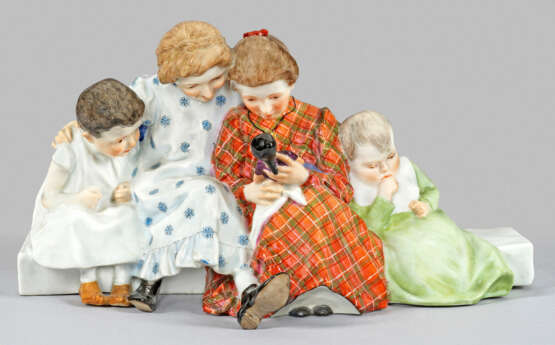ID 1339190
Lot 20 | Äußerst seltene frühe Ausformung einer Hentschel-Gruppe
Estimate value
€ 16 000 – 32 000
"Vier spielende Kinder auf einer Bank" von Meissen
Sitzende Gruppe von zwei älteren Mädchen in grün, rotbraun kariertem bzw. geblümtem weißen Kleid, eine Puppe betrachtend. Flankierend ein jüngeres Kind und ein eingeschlafenes Kleinkind in mintgrünem Kleid. Polychrome Aufglasurmalerei mit wenig Gold. Entw. Konrad Hentschel, 1906. Modell-Nr. W 166. Minim. rest.; Schwertermarke. H. 14 cm. 25 cm x 13,5 cm.
Äußerst seltene, frühe Ausformung einer Hentschel-Gruppe, die in geringer Stückzahl ausgeführt wurde. Der bereits 1907 verstorbene Julius Konrad Hentschel gilt als einer der bedeutendsten Jugendstilkünstler in Meissen und trug um die Jahrhundertwende maßgeblich an der "Erneuerung" der Meissener Porzellanplastik bei. Er besuchte ab 1889 die Zeichenschule der Meissener Porzellan-Manufaktur, studierte zwischen 1891 und 1893 an der Münchner Kunstakademie und wurde schließlich 1897 als Modelleur an der Manufaktur angestellt. Er schloss 1901 ein weiteres Studium an der Dresdner Kunstakademie ab, an der er unter Prof. Robert Diez und Prof. Carl Heinrich Epler studierte. Vor allem die Figurenreihe von 12 spielenden Kindern, die zwischen 1904 und 1907 entstanden, wurden beispielhaft für den Meissener Jugendstil und bereits Anfang des 20. Jhs. zum Kassenschlager. Sie erfreuen sich bis heute großer Beliebtheit. Eine nahezu identische Figurengruppe befindet sich im Stadtmuseum in Dresden.
Vgl. Just, Meissener Jugendstil Porzellan, Abb. 33; Berling, Taf. 36, Abb. 1; Meissener Manuskripte, Sonderheft III, Abb. S. 4, 6-7.
A very rare porcelain figure group of four children playing with a doll modelled by K. Hentschel in 1906. Minor restored. Crossed swords mark.
Meissen. Um 1906 - 1923.
| Address of auction |
Kunstauktionshaus Schloss Ahlden GmbH Große Str. 1 29691 Ahlden(Aller) Germany | ||||||||||||||
|---|---|---|---|---|---|---|---|---|---|---|---|---|---|---|---|
| Preview | |||||||||||||||
| Phone | +49 5164 80100 | ||||||||||||||
| Buyer Premium | 25.0 | ||||||||||||||
| Conditions of purchase | Conditions of purchase | ||||||||||||||
| Business hours | Business hours
|



